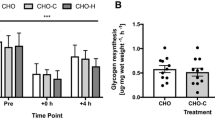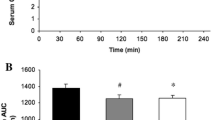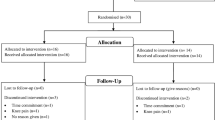Abstract
The purpose of this study was to determine if the co-ingestion of carbohydrate (CHO) with branched-chain amino acids (BCAA) or l-leucine (LEU) preferentially affected serum IGF-1 and the expression of myogenic-related genes in response to resistance exercise (RE). Forty-one college-age males were randomly assigned to 1 of 4 groups: CHO, CHO-BCAA, CHO-LEU, or placebo (PLC). Resistance exercise consisted of 4 sets of 10 repetitions of leg press and leg extension at 80 % 1RM. Supplements were ingested peri-exercise, and venous blood and muscle biopsies were obtained pre-exercise (PRE), and at 30, 120, and 360 min post-exercise. Serum IGF-1 was determined with ELISA, and skeletal muscle mRNA expression of myostatin, ACTRIIB, p21kip, p27kip, CDK2, cyclin B1, cyclin D1, Myo-D, myogenin, MRF-4, and myf5 was determined using real-time PCR. Results were analyzed by two-way ANOVA for serum IGF-1 and two-way MANOVA for mRNA expression. Serum IGF-1 in CHO + BCAA was greater than PLC (p < 0.05) but was not affected by RE (p > 0.05). A significant group × time interaction was located for cylin D1 (p < 0.05), but not for any other genes. However, significant time effects were noted for cyclin B1 and p21cip (p < 0.05). At 30, 120 and 360 min post-exercise, p21cip was significantly less than PRE. Cyclin D1 was greater than PRE and 30 min post-exercise at 120 and 360 min post-exercise, whereas cyclin B1 was significantly greater than PRE at 120 min post-exercise (p < 0.05). Unlike the co-ingestion of CHO with either BCAA or l-leucine in conjunction with RE, the expression of various myogenically related genes were up-regulated with RE.

Similar content being viewed by others
References
Ausubel F, Brent R, Kingston R, Moore D, Seidman J, Smith J, Struhl K (2002) Short protocols in molecular biology, 5th edn. Wiley Publishers, Hoboken
Bergstrom J (1975) Percutaneous needle biopsy of skeletal muscle in physiological and clinical research. Scand J Clin Lab Invest 35:609–616
Bickel CS, Slade J, Mahoney E, Haddad F, Dudley GA, Adams GR (2005) Time course of molecular responses of human skeletal muscle to acute bouts of resistance exercise. J Appl Physiol 98:482–488
Biolo G, Tipton KD, Klein S, Wolfe RR (1997) An abundant supply of amino acids enhances the metabolic effect of exercise on muscle protein. Am J Physiol 273:E122–E129
Di Camillo B, Eduati F, Nair SK, Avogaro A, Toffolo GM (2014) Leucine modulates dynamic phosphorylation events in insulin signaling pathway and enhances insulin-dependent glycogen synthesis in human skeletal muscle cells. BMC Cell Biol 15:9
Drummond MJ, Glynn EL, Fry CS, Dhanani S, Volpi E, Rasmussen BB (2009a) Essential amino acids increase microRNA-499, -208b, and -23a and downregulate myostatin and myocyte enhancer factor 2C mRNA expression in human skeletal muscle. J Nutr 139:2279–2284
Drummond MJ, Miyazaki M, Dreyer HC, Pennings B, Dhanani S, Volpi E, Esser KA, Rasmussen BB (2009b) Expression of growth-related genes in young and older human skeletal muscle following an acute stimulation of protein synthesis. J Appl Physiol 106:1403–1411
Evans WJ, Phinney SD, Young VR (1982) Suction applied to a muscle biopsy maximizes sample size. Med Sci Sports Exerc 14:101–102
Farup J, Rahbek SK, Riis S, Vendelbo MH, Paoli F, Vissing K (2014) Influence of exercise contraction mode and protein supplementation on human skeletal muscle satellite cell content and muscle fiber growth. J Appl Physiol 117:898–909
Ferreira MP, Li R, Cooke M, Kreider RB, Willoughby DS (2014) Periexercise coingestion of branched-chain amino acids and carbohydrate in men does not preferentially augment resistance exercise-induced increases in phosphatidylinositol 3 kinase/protein kinase B-mammalian target of rapamycin pathway markers indicative of muscle protein synthesis. Nutr Res 34:191–198
Han B, Tong J, Zhu MJ, Ma C, Du M (2008) Insulin-like growth factor-1 (IGF-1) and leucine activate pig myogenic satellite cells through mammalian target of rapamycin (mTOR) pathway. Mol Reprod Dev 75:810–817
Harber MP, Crane JD, Dickinson JM, Jemiolo B, Raue U, Trappe TA, Trappe SW (2009) Protein synthesis and the expression of growth-related genes are altered by running in human vastus lateralis and soleus muscles. Am J Physiol Regul Integr Comp Physiol 296:R708–R714
Harber MP, Konopka AR, Jemiolo B, Trappe SW, Trappe TA, Reidy PT (2010) Muscle protein synthesis and gene expression during recovery from aerobic exercise in the fasted and fed states. Am J Physiol Regul Integr Comp Physiol 299:R1254–R1262
Hulmi JJ, Ahtiainen JP, Kaasalainen T, Pollanen E, Hakkinen K, Alen M, Selanne H, Kovanen V, Mero A (2007) Postexercise myostatin and activin IIb mRNA levels: effects of strength training. Med Sci Sports Exerc 39:289–297
Hulmi JJ, Kovanen V, Lisko I, Selanne H, Mero AA (2008) The effects of whey protein on myostatin and cell cycle-related gene expression responses to a single heavy resistance exercise bout in trained older men. Eur J Appl Physiol 102:205–213
Jahn L, Sadoshima J, Izumo S (1994) Cyclins and cyclin-dependent kinases are differentially regulated during terminal differentiation of C2C12 muscle cells. Exp Cell Res 212:297–307
Karlsson HK, Nilsson PA, Nilsson J, Chibalin AV, Zierath JR, Blomstrand E (2004) Branched-chain amino acids increase p70S6k phosphorylation in human skeletal muscle after resistance exercise. Am J Physiol Endocrinol Metab 287:E1–E7
Kim JS, Cross JM, Bamman MM (2005) Impact of resistance loading on myostatin expression and cell cycle regulation in young and older men and women. Am J Physiol Endocrinol Metab 288:E1110–E1119
Kimball SR, Jefferson LS (2006) New functions for amino acids: effects on gene transcription and translation. Amer J Clin Nutr 83:500S–507S
Knight JD, Kothary R (2011) The myogenic kinome: protein kinases critical to mammalian skeletal myogenesis. Skelet Muscle 1:1–18
Kraemer RR, Kilgore JL, Kraemer GR, Castracane VD (1992) Growth hormone, IGF-I, and testosterone responses to resistive exercise. Med Sci Sports Exerc 24:1346–1352
Langley B, Thomas M, Bishop A, Sharma M, Gilmour S, Kambadur R (2002) Myostatin inhibits myoblast differentiation by down-regulating MyoD expression. J Biol Chem 277:49831–49840
Lundby C, Nordsborg N, Kusuhara K, Kristensen KM, Neufer PD, Pilegaard H (2005) Gene expression in human skeletal muscle: alternative normalization method and effect of repeated biopsies. Eur J Appl Physiol 95:351–360
Mahoney DJ, Carey K, Fu MH, Snow R, Cameron-Smith D, Parise G, Tarnopolsky M (2004) Real-time RT-PCR analysis of housekeeping genes in human skeletal muscle following acute exercise. Physiol Genomics 18:226–231
Miller SL, Tipton KD, Chinkes DL, Wolf SE, Wolfe RR (2003) Independent and combined effects of amino acids and glucose after resistance exercise. Med Sci Sports Exerc 35:449–455
O’Connor K, Stip E, Pelissier MC, Aardema F, Guay S, Gaudette G, Van Haaster I, Robillard S, Grenier S, Careau Y, Doucet P, Leblanc V (2007) Treating delusional disorder: a comparison of cognitive-behavioural therapy and attention placebo control. Can J Psychiatr Rev 52:182–190
Philippou A, Halapas A, Maridaki M, Koutsilieris M (2007) Type I insulin-like growth factor receptor signaling in skeletal muscle regeneration and hypertrophy. J Musculoskelet Neuronal Interact 7:208–218
Psilander N, Damsgaard R, Pilegaard H (2003) Resistance exercise alters MRF and IGF-I mRNA content in human skeletal muscle. J Appl Physiol 95:1038–1044
Rennie MJ (2007) Exercise- and nutrient-controlled mechanisms involved in maintenance of the musculoskeletal mass. Biochem Soc Trans 35:1302–1305
Schumm SR, Triplett NT, McBride JM, Dumke CL (2008) Hormonal response to carbohydrate supplementation at rest and after resistance exercise. Int J Sport Nutr Exerc Metab 18:260–280
Serra MC, Beavers KM, Beavers DP, Willoughby DS (2012) Effects of 28 days of dairy or soy ingestion on skeletal markers of inflammation and proteolysis in post-menopausal women. Nutr Health 21:117–130
Shelmadine B, Cooke M, Buford T, Hudson G, Redd L, Leutholtz B, Willoughby DS (2009) Effects of 28 days of resistance exercise and consuming a commercially available pre-workout supplement, NO-Shotgun, on body composition, muscle strength and mass, markers of satellite cell activation, and clinical safety markers in males. J Int Soc Sports Nutr 6:16
Skapek SX, Rhee J, Spicer DB, Lassar AB (1995) Inhibition of myogenic differentiation in proliferating myoblasts by cyclin D1-dependent kinase. Science 267:1022–1024
Taylor LW, Wilborn CD, Kreider RB, Willoughby DS (2012) Effects of resistance exercise intensity on extracellular signal-regulated kinase 1/2 mitogen-activated protein kinase activation in men. J Strength Cond Res 26:599–607
Whaley MH, Brubaker PH, Otto RM, Armstrong LE (2006) ACSM guidelines for exercise testing and prescription, 7th edn. Lippincott Williams & Wilkins, Philadelphia
Wilborn CD, Taylor LW, Greenwood M, Kreider RB, Willoughby DS (2009) Effects of different intensities of resistance exercise on regulators of myogenesis. J Strength Cond Res 23:2179–2187
Willoughby DS, Nelson MJ (2002) Myosin heavy-chain mRNA expression after a single session of heavy-resistance exercise. Med Sci Sports Exerc 34:1262–1269
Willoughby DS, Stout JR, Wilborn CD (2007) Effects of resistance training and protein plus amino acid supplementation on muscle anabolism, mass, and strength. Amino Acids 32:467–477
Acknowledgments
The authors would like to thank all of the individuals who participated in the study.
Conflict of interest
The authors declare no conflicts of interest.
Author information
Authors and Affiliations
Corresponding author
Additional information
Handling Editor: E. Rawson.
Rights and permissions
About this article
Cite this article
Li, R., Ferreira, M.P., Cooke, M.B. et al. Co-ingestion of carbohydrate with branched-chain amino acids or l-leucine does not preferentially increase serum IGF-1 and expression of myogenic-related genes in response to a single bout of resistance exercise. Amino Acids 47, 1203–1213 (2015). https://doi.org/10.1007/s00726-015-1947-8
Received:
Accepted:
Published:
Issue Date:
DOI: https://doi.org/10.1007/s00726-015-1947-8




